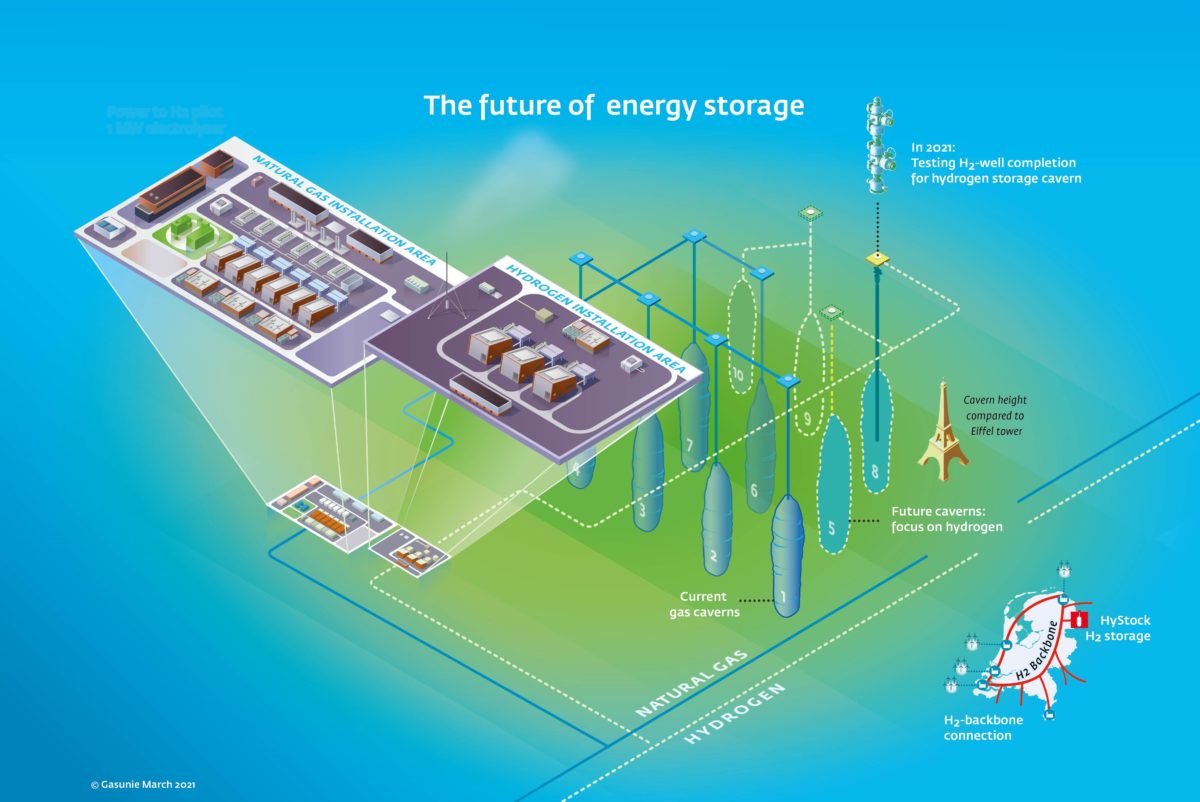Bilfinger and Gasunie aim to commission the first hydrogen cavern in the Netherlands by 2026, storing energy from wind parks and PV installations in deep underground salt layers near Zuidwending. “The compressor stations will inject around 76 million cubic meters of hydrogen gas into each of the four planned caverns,” wrote the engineering company. The aim is to establish a total storage capacity of approximately 26 million kg of hydrogen. Bilfinger will provide equipment, piping, pipelines, buildings, and related infrastructure. Gasunie, the Dutch natural gas infrastructure company, runs the HyStock project and injected hydrogen into the subsurface at the Zuidwending site in September 2021.
Porsche has released a concept study for a hydrogen combustion engine with an output of around 440 kW and a maximum speed of 261 km/h. “The starting point for our study was an existing 4.4-liter, eight-cylinder gasoline engine – or rather, its digital data set, since we conducted the entire study virtually using engine performance simulations,” said Vincenzo Bevilacqua, senior expert engine simulation at Porsche Engineering. Modifications to the engine model included a new turbocharging system, a higher compression ratio, and combustion adapted to hydrogen. Porsche tried to solve the lower exhaust gas temperatures, which result in a lack of energy for their propulsion on the exhaust side, through a turbocharging system with back-to-back compressors. “The special feature of this design is the coaxial arrangement of two compressor stages, which are driven by the turbine or the supporting electric motor using a common shaft. The process air flows through the first compressor, is cooled in the intercooler and then recompressed in the second stage,” wrote the German automobile manufacturer.
Fusion Fuel has received confirmation from the Portuguese government that it will secure an estimated €10 million grant to develop its 6.6MW HEVO-Industria green hydrogen project in Sines, Portugal. “The HEVO-Industria project, which is expected to take FID in the first half of 2023 and require €25 million of capital investment, consists of 300 HEVO-Solar units along with a hydrogen refueling station and associated balance of plant to support local industry, and will produce an estimated 764 tons of green hydrogen per annum,” wrote the Irish hydrogen company. Fusion Fuel, which focuses on PEM electrolysis, said that the green hydrogen is expected to be used for mobility and industrial applications in Sines, or blended in the natural gas grid.
Woodside Energy, BGC, and Centurion are advancing plans for a hydrogen production, storage, and refueling station in the Rockingham Industry Zone, Australia. The companies plan to deploy a 2 MW electrolyzer, powered by renewable energy sourced from the South West Interconnected System during periods of excess solar in the grid. “With matched funding from Woodside, the proposal targets delivery of hydrogen fuel at a globally competitive price of AUD 11 ($7.57) per kilo and subsidizes a number of large hydrogen fuel cell electric vehicles,” wrote the Australian petroleum company. Woodside has signed non-binding offtake memoranda of understanding with BGC and Centurion. The project should be located adjacent to Woodside’s proposed H2Perth project, a proposed domestic and export-scale hydrogen and ammonia production facility. The Australian government selected the project for its AUD 10 million Hydrogen Fuelled Transport Program.
The Queensland state government has opened a consultation on a hydrogen project proposal in Gladstone, Australia, after releasing draft terms of reference for the environmental impact statement. The AUD 4.7 billion project has a planned capacity of up to 3 GW of electrolysis and up to 5,000 tons per day of green ammonia production.
Shell and H2 Mobility Germany have commissioned a filling station at the Wesseling Shell station near the city of Cologne. H2 Mobility Deutschland built the station using Linde’s filling station technology. Shell operates a 10 MW PEM electrolyzer to produce green hydrogen at the Shell Energy and Chemicals Park Rheinland near the filling station.
This content is protected by copyright and may not be reused. If you want to cooperate with us and would like to reuse some of our content, please contact: editors@pv-magazine.com.



By submitting this form you agree to pv magazine using your data for the purposes of publishing your comment.
Your personal data will only be disclosed or otherwise transmitted to third parties for the purposes of spam filtering or if this is necessary for technical maintenance of the website. Any other transfer to third parties will not take place unless this is justified on the basis of applicable data protection regulations or if pv magazine is legally obliged to do so.
You may revoke this consent at any time with effect for the future, in which case your personal data will be deleted immediately. Otherwise, your data will be deleted if pv magazine has processed your request or the purpose of data storage is fulfilled.
Further information on data privacy can be found in our Data Protection Policy.